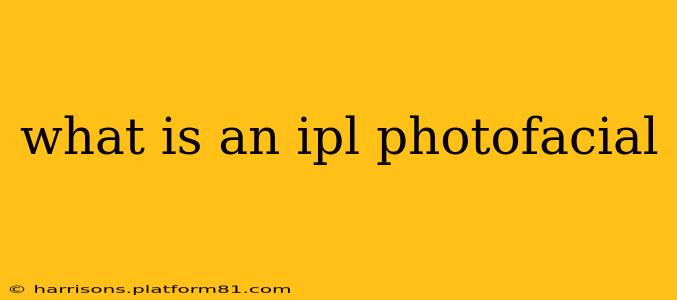An IPL photofacial, also known as intense pulsed light therapy, is a non-invasive cosmetic procedure that uses broad-spectrum light to treat various skin concerns. It's a popular choice for improving skin tone, texture, and reducing the appearance of several common skin imperfections. Unlike laser treatments which use a single wavelength of light, IPL utilizes a range of wavelengths, targeting multiple skin issues simultaneously. This makes it a versatile and effective treatment option for many individuals.
How Does an IPL Photofacial Work?
IPL photofacials work by delivering pulses of intense light energy to the skin. This light energy is absorbed by chromophores—molecules that absorb light—in the skin, such as melanin (responsible for pigmentation) and hemoglobin (found in blood vessels). The light energy then converts into heat, which triggers a series of beneficial effects:
- Reduces pigmentation: The heat targets melanin, breaking down sunspots, age spots, freckles, and other forms of hyperpigmentation.
- Improves skin texture: The heat stimulates collagen production, leading to firmer, smoother skin and a reduction in fine lines and wrinkles.
- Reduces redness: The heat targets hemoglobin in blood vessels, reducing redness caused by rosacea, broken capillaries, and facial flushing.
- Improves overall skin tone: By addressing pigmentation and redness, IPL photofacials create a more even and radiant complexion.
What Skin Conditions Does IPL Photofacial Treat?
IPL photofacials are effective for a wide range of skin concerns, including:
- Sun damage (sunspots, age spots): IPL effectively targets and reduces the appearance of age spots caused by sun exposure.
- Rosacea: The treatment can diminish redness and inflammation associated with rosacea.
- Broken capillaries: IPL helps to seal and fade the appearance of broken blood vessels.
- Hyperpigmentation: This includes various types of discoloration, such as melasma and age spots.
- Acne scars: IPL can improve the appearance of some acne scars by stimulating collagen production.
- Fine lines and wrinkles: While not as effective as other treatments like laser resurfacing, IPL can help to improve the appearance of fine lines and wrinkles by boosting collagen production.
What are the Benefits of IPL Photofacial?
- Non-invasive: It requires no surgery or incisions, minimizing recovery time.
- Minimal downtime: Most patients experience minimal downtime after treatment.
- Multiple skin concerns addressed simultaneously: IPL targets multiple skin issues in a single session.
- Improved skin tone and texture: It results in a smoother, more even skin tone.
- Relatively quick treatment sessions: Sessions typically last between 15-30 minutes.
- Long-lasting results: While results are not permanent, they can last for several months or even years with proper sun protection.
What Happens During an IPL Photofacial Treatment?
Before the procedure, a healthcare professional will assess your skin and discuss your expectations. They might recommend a test patch to evaluate your skin's response to the treatment. During the procedure, a cooling gel is applied to the skin, and the IPL device is moved across the treatment area, delivering pulses of light. You may feel a slight snapping or warming sensation during the treatment.
How Many IPL Photofacial Treatments Are Needed?
The number of treatments required depends on individual skin conditions and desired outcomes. Most people require a series of 3-6 treatments, spaced several weeks apart.
What are the Side Effects of IPL Photofacial?
Side effects are generally mild and temporary. They may include:
- Redness and swelling: This is common immediately after treatment and usually subsides within a few hours.
- Mild bruising: This is less common but possible.
- Temporary darkening or lightening of the skin: This is usually temporary and resolves within a few weeks.
- Crusting or scabbing: This can occur in some cases and typically heals within a few days.
It's crucial to follow your healthcare provider's post-treatment instructions to minimize the risk of side effects and optimize results.
Is IPL Photofacial Right for Me?
IPL photofacials are generally safe for most skin types, but it's important to consult with a dermatologist or qualified medical professional to determine if this treatment is right for you. They will assess your skin condition, discuss your expectations, and advise you on the best course of action. They can also inform you about the potential risks and benefits specific to your skin type and concerns. Individuals with certain medical conditions or those taking certain medications may not be suitable candidates for IPL photofacials.
What Should I Expect After an IPL Photofacial?
After the procedure, your skin may be red and slightly swollen. Avoid direct sun exposure and use a broad-spectrum sunscreen with an SPF of 30 or higher to protect your skin. Your healthcare provider will give you specific instructions on how to care for your skin after the treatment.
This comprehensive guide provides a thorough understanding of IPL photofacials. Remember, always consult with a qualified medical professional before undergoing any cosmetic procedure. They can assess your individual needs and provide personalized recommendations.
